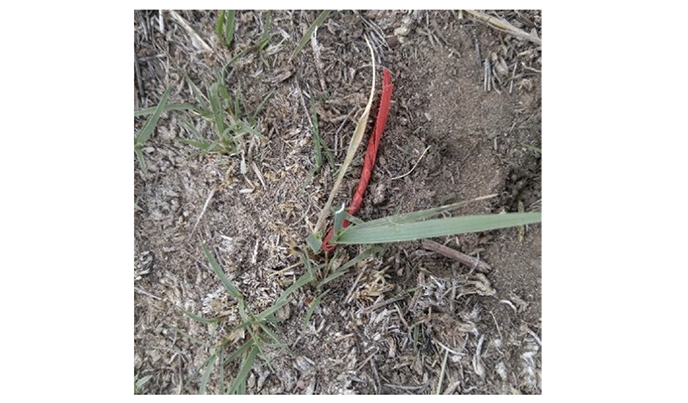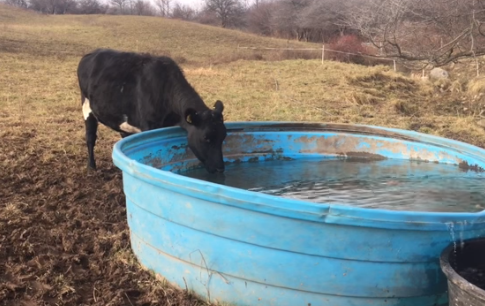
In this month’s The Thinking Grazier, we’re looking at some research that might challenge some of our preconceived notions. I’ve included questions we can ask ourselves as we consider what to do with this information. You can also download the paper with the link to the right.
Preventing animals from taking that “second bite” or regrazing an individual plant before it has time to recover is a basic tenet of managed grazing. It’s the reason many use adaptive, multipaddock grazing both to prevent regrazing and to increase production of grasses that might be harmed most by that second bite.
But what if our assumptions about regrazing and how rotational grazing prevents it are wrong? That’s the question that stakeholders asked researchers to explore as part of the Collaborative Adaptive Rangeland Management experiment (CARM). The unexpected result might have you rethinking how you manage your own pastures.
What makes this experiment different?
 The Collaborative Adaptive Rangeland Management Experiment (CARM) is different because it tests real management practices, at a ranch scale. Eleven stakeholders, including ranchers, researchers, state and federal land managers, and staff from environmental conservation organizations set goals and objectives and make decisions to manage grazing for healthy vegetation and wildlife habitat as well as profitable ranching.
The Collaborative Adaptive Rangeland Management Experiment (CARM) is different because it tests real management practices, at a ranch scale. Eleven stakeholders, including ranchers, researchers, state and federal land managers, and staff from environmental conservation organizations set goals and objectives and make decisions to manage grazing for healthy vegetation and wildlife habitat as well as profitable ranching.
Stakeholders are particularly interested in comparing adaptive rotational grazing to traditional management (season-long grazing from early-May to early-October). So, they set up a system of ten pairs of 320-acre pastures similar in size, soil, and vegetation. In one set of ten pastures, stakeholders grouped steers into one large herd and rotated them among eight of the pastures, with two set aside for planned rest as a drought management strategy and to meet vegetation and wildlife objectives. These pastures are labeled as CARM for Collaborative Adaptive Rangeland Management. In the other set of ten pastures, the same total number of animals are split into ten small herds that graze season-long, creating the same ranch-scale stocking rate as the rotationally grazed pastures. These season-long pastures are labeled as TRM for Traditional Rangeland Management. Since the project began in 2012, researchers have been monitoring and measuring outcomes, and stakeholders have been adjusting management based on that information.

Western Wheatgrass and Regrazing
Western wheatgrass is a cool season (C3) grass and stakeholders would like to have more of it in their pastures. So, they asked researchers to set up a study that would help them find out if their management was preventing cattle from regrazing and reducing the grass’s health.

The study team set up 40 monitoring plots – four in each pasture. Then, before the grazing season began, they used plastic twist ties placed at ground level to mark western wheatgrass tillers along a transect in each of 3 plots per pasture (30 tiller transects total). Since this was a two-year experiment, different tillers were marked in year two. These tillers were monitored and measured repeatedly through the growing/grazing season. Adaptively managed pastures were counted and measured twice per week while the large herd was in the pasture. Then they were measured again once per month when cattle were no longer in the pasture to capture any grazing by wildlife. In the continuously grazed, TRM pastures, tillers were monitored every other week.
But this description of the sampling process doesn’t do justice to the hard work being done. Imagine 15 research assistants crawling around on the shortgrass prairie wrapping tillers with plastic twist ties; then crawling around again, week after week, to count grazed and ungrazed tillers and paint the tiny tops of the grazed ones with a little white paint so they could track whether a tiller was grazed twice. It takes a lot of dedication to do this kind of detailed work.
What did the data say?
There were a number of take homes from this study, some expected, some unexpected. Let’s take them one by one.
The Expected
Regrazing is bad.
Regrazed tillers, or those that had only been grazed once, were shorter than their ungrazed counterparts, reinforcing this long-time lesson.
Timing matters.
Staying in a pasture longer or being in a pasture early in the season when the species is most palatable, DOES lead to more grazing and regrazing of tillers.
In this study, pastures that were grazed early in the season by the CARM treatment with higher stock density showed more regrazing than either the CARM pastures grazed later, or the TRM continuously grazed pastures.
The Unexpected
The surprise here is the grazing system (CARM vs TRM) had little influence on the frequency or intensity of grazing at the ranch scale. In fact, the results of Traditional Range Management are very similar to the adaptively managed results as you can see below in this ranch-level summary of tiller regrazing. Researchers and stakeholders were surprised to find out that in the TRM pastures, at moderate stocking rates, leaving cattle in one place does NOT mean that all tillers of a palatable species get grazed. In fact, roughly 2/3 of the tillers never got grazed, even under continuous season-long stocking.

Season of use did make a difference as the graphs below illustrate. In the CARM treatment, some pastures got grazed quite heavily, but this was offset by other pastures that got grazed very lightly. In contrast, TRM pastures were grazed more evenly across the board. Any regrazing happened during the early season when western wheatgrass was more palatable, and stock density (more animals for a short time) was higher.

The most important take home message
Stocking rate is the major driver behind how many plants are regrazed, NOT the grazing system.
If you notice, each of the graphs above include a block for “light” grazing and one for “heavy grazing.” These represent data from pastures included in a study that has been ongoing since 1939 comparing a light stocking rate (20% utilization) and a heavy stocking rate (60% utilization).
When you look at the data and compare the results of the heavily stocked pasture to the moderately stocked CARM and TRM pastures, you see what happens when stocking rates increase. If you have too many animals grazing, you’re going to run into regrazing no matter what you do. In contrast, season-long rest is “built-in” for ranches stocked at light-to-moderate rates, regardless of grazing system.
Even if managers adaptively managed this heavy stocking by rotating them through pastures, nothing would change. As Dr. Porensky pointed out when we spoke, at a ranch scale, it’s a zero-sum game. Less grazing in one pasture leads to more grazing elsewhere. As a result, rotation doesn’t affect the total amount of grazing and regrazing across all pastures.
Simply rotating without attention to stocking rate is NOT a silver bullet.
Management Implications
Here’s what the authors of the paper conclude:
“We found that CARM grazing did not lower rates of grazing and regrazing on western wheatgrass tillers at the ranch scale in the shortgrass steppe, when compared with season-long continuous grazing at the same stocking rate. Thus, the use of adaptive multipaddock rotational grazing strategies should not be expected to enhance abundance of this palatable, cool-season species. In fact, when viewing the world form the humble perspective of a western wheatgrass tiller, it is apparent that season-long rest is built into season-long continuous grazing and rotational systems. More than 50 years ago Morris (1969) wisely summarized that “under the system of ‘correctly [moderately] stocked’ continuous grazing, described here, plants were grazed neither frequently nor severely…Individual small areas in these ‘continuously grazed’ swards were thus grazed rotationally.”
In the end, like many previous studies, we conclude that stocking rate is a far more important driver of ranch-scale defoliation intensity and frequency than…movement of cattle among paddocks.”
The authors also point out that this does not mean that adaptive rotational grazing is not a valuable management tool. It could be very useful for achieving objectives specific to individual pastures. For example, managers could use this information to minimize or maximize impacts on western wheatgrass or on other species, or as a means for improving wildlife habitat, or for changing populations of palatable species within a pasture. The thing to remember is that any decision to decrease use of one pasture will lead to increased use of other pastures, unless ranchers utilize supplemental feeding or off-ranch forage.
Thinking about it
 A good question for Thinking Graziers is “Why is it that the grazing system is not more important in this case?”
A good question for Thinking Graziers is “Why is it that the grazing system is not more important in this case?”
Dr. Porensky had this same question and has some ideas about the answer:
Cattle shift diet preferences as plant palatability changes through the season. Other studies suggest that plant height and forage quality can influence regrazing. When grazing on the shortgrass prairie, animals get more per bite from longer, ungrazed plants. In addition, western wheatgrass declines in quality as the season progresses, and other forages become more palatable, so animals choose them instead. In addition, in the shortgrass system, regrowth depends on rain that may or may not come, limiting palatable regrowth. This all combines to mean less regrazing of western wheatgrass tillers.
It also means, in this system, regrazing to keep plants in the vegetative stage is not likely to work as well as it does in systems with lots of precipitation and lots of plant regrowth. This is a really important point when thinking about your grazing management. If you’re in an area with lots of precipitation, and lots of regrowth there is more potential for regrazing and more potential benefit from rotation. Still, the researchers caution that “several studies in mesic systems have failed to document strong effects of grazing system on levels of selectivity or regrazing rates at the plant scale. Further research is needed to identify the specific conditions under which rotation may influence regrazing frequencies.” (page 137 of the paper.)
Other questions you might consider:
How do I feel about this and why?
Are you feeling some discomfort? Are you surprised? I talk about those responses in this week’s (free) Notes from Kathy.
How similar or different are my grasses and environment to western wheatgrass and the shortgrass prairie and what does that mean for my management?
As the authors of this paper point out, different species have different regrowth capabilities. Knowing how the grasses you grow function, can help you decide if you might make changes based on what you learned here.
How is my stocking rate potentially affecting regrazing of individual grass plants?
In my region, would a moderate stocking rate decrease labor costs while maintaining vegetation health and livestock productivity?
Do you have other questions that come up, or things that you’re thinking about? Share them with your On Pasture community in the comments below.




Great article! Thanks for publishing. I’m curious how this would pan out in areas where there there are mostly cool season grasses (not cool and warm) and limited opportunities for regrowth within the growing season. Also the “tiller net” sounds cool – I’d like to learn from such a network.
The concern I have with this research is the comfort level the authors have with the idea of “In contrast, season-long rest is “built-in” for ranches stocked at light-to-moderate rates, regardless of grazing system.”
This paradigm accepts the revenue flow limitation of low-moderate stocking rates. Most ranches cannot afford that restrictive stocking rate strategy simply due to the tiny profit margin of conventional ranching. To be profitable, most ranches need greater animal yield per acre. Increasing stocking rate is how we accomplish that. Mitigating the impact of increased stocking rate on the range is accomplished through reducing the grazing period duration. (i.e. increased stock density)
I look at the graphs for non-grazed tillers in both the CARM & TRM pastures and my reading is that they are grossly understocked. My grazing management objective even on semi-arid rangeland is to get a bite off every tiller and then provide adequate recovery time following that bite.
The only way to accomplish that strategy is to shorten the grazing period to increase stock density. In the CARM study, the grazing periods were far too long to accomplish a meaningful change in plant response. I am generally advocating 3-5 day grazing periods on semi-arid range.
I have seen far too many ranches completely rejuvenate their rangelands with a shift to short-duration grazing periods and extended recovery to worry about whether or not academic research supports or disputes the notion.
Hi,
An interesting article, my observation is that it focuses on only one species of grass, we are in Australia and don’t have this species. We have been practicing planned grazing for 20 years and have observed a radical increase in the diversity of plants, be they grasses, herbs forbs or wildflowers. Our Stocking rate and density have increased dramatically as well.
Whilst TRM appears to have no influence on the overgrazing of Wheatgrass, my concern is for the diminution of the other species and an oversimplification of my sward. I am constantly seeking further complexity in my diversity and find that grasslands that have been managed traditionally here have simplified to only 2 or 3 species of lower successional grasses.
I would welcome any comments and further enlightenmnet.
In this grassland, western wheat was the species that producers wanted to increase because it is subdominant to the shortgrasses. We are monitoring all grass species (about about 8 of which are common). Plus many forbspecies. With 8 years of treatments we have not yet seen any notable divergence in the two treatments in terms of diversity.
Should we be looking at stocking rate or stocking density? Stocking rate is basically number of animals and doesn’t differentiate between different animal classes. Stocking density looks at body weight and pounds per acre, totally different
Hello Friends,
Based on all the comments I’ve gotten on this piece so far, I believe there is possible miscommunication on my part and misunderstanding on readers’ parts. So let me clarify.
The ranching stakeholders in this collaborative group believe that adaptive rotational grazing is better than traditional season-long grazing for a number of reasons. One is that it would preventing regrazing of a species of grass they would like to have more of in their pastures.
So – the question was, does this kind of management make a difference to regrazing? We’ve always believed it does. But as far as I know, this is the first study to actually do the tedious work of marking and monitoring grass tillers to see what was happening. What the stakeholders learned is that there was very little regrazing of Western wheatgrass, whether in the adaptively managed pastures or in the traditionally grazed pastures.
This is not a take down of adaptive management. The authors point out that it is a valuable tool to reach many goals. This is simply new information about whether or not it is the tool we should use to prevent regrazing. Their data show that stocking rate is actually the major driver of regrazing.
There are lots of ideas about what adaptive managed grazing looks like, but that’s not what this paper or article is about. If that’s what you addressed in your comment, you won’t see it appear below. I’d like to keep the discussion on topic. The CARM stakeholders have given us some input that helps us think about what we know about how the grasses in our own pastures grow, what prevents regrazing, and what we might do with these new ideas. We’ve learned something about how things work on the shortgrass prairie, but they could be different elsewhere. In fact, when I talked to Dr. Porensky, she was so excited to learn more that she hopes for a “Tiller Net” where other studies in other places add to our understanding.
I hope that helps clarify things and constructively guides our conversation. If you have questions, drop me an email. kathy@onpasture.com
I read the paper, and I wonder what difference it would have made if the TRM herd were not divided equally between the 10 TRM paddocks. It seems like this structure mitigated some of the effects of a herd’s tendency to prefer certain areas of a ranch and avoid others. Their model forced some grazing distribution across the whole of the ranch (although not within each of the TRM pastures). Under a pure continuous grazing model, there would be one herd with access to the entire ranch. With a pure continuous grazing model, I would expect some areas of the ranch to be heavily utilized, and other areas to be unutilized. The “whole ranch” data might not be much different, but specific areas within the ranch might be very different.
That is a good point. We stil need to better understand how the size of seasonlong pastures affects grazing distribution and regrazing. My experience is that many ranchers still avoid significant regrazing of individual plants in much larger seasonlong paddocks (which are common in this region) as long as they have multiple welldistributed water sources.
Comments are closed.